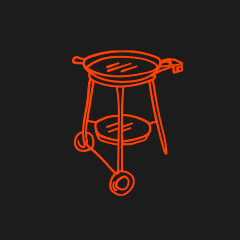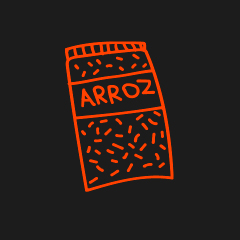HOW TO REMOVE RUST FROM OUR PAELLA
A rusty paella pan doesn't mean it's a lost cause. In fact, it's quite common for paella pans—especially polished steel ones—to develop rust if they’re not properly maintained.
In this guide, we’ll show you how to effectively remove rust, how to season the pan after cleaning it, and how to prevent it from rusting again.
Why does a paella pan rust?
Rust forms when steel comes into prolonged contact with moisture and oxygen in the air. This often happens when the pan isn’t dried properly after use, isn’t protected with a layer of oil, or is stored in a damp place.
Polished steel paella pans, which are not enamelled or coated, are particularly vulnerable to this issue. The good news is that surface rust is completely treatable if addressed in time.
How to effectively clean a rusty paella pan
Here’s what you need to know to remove rust from your paella pan, from the materials to the step-by-step instructions:
Materials needed to clean the pan
- Rust remover (like Asevi or similar)
- Non-abrasive sponge or scrub pad
- Mild soap
- Hot water
- Paper towels or dry cloth
- Vegetable oil (sunflower or olive)
Steps to remove rust from the paella pan
- Identify the rusted area: Sometimes rust only affects part of the pan. Still, it’s important to treat the whole pan to prevent it from coming back.
- Apply the rust remover: Place a small amount of the product directly on the rusty area. Let it sit for a few seconds or follow the manufacturer’s instructions.
- Gently scrub: Use a sponge or non-metallic scrub pad to rub the area until the rust begins to come off. You may need to repeat this step if the rust is stubborn.
- Rinse and wash with soap: Once the rust is removed, wash the entire pan with water and mild soap to remove any remaining rust remover.
- Dry completely: Use paper towels or a clean cloth to thoroughly dry the pan. Do not air dry, as this can lead to new rust forming.
How to season a paella pan after removing rust
Once the rust has been removed, it’s essential to protect the pan to keep it from rusting again. This is where the “seasoning” process comes in. You can watch a video on how to do this on our blog post Paella Maintenance.
To season it, fill your pan with water up to the rivets—or about halfway if it doesn’t have rivets—and heat the water until it boils. Keep it boiling for 10–15 minutes. Once done, discard the water, wash with soap, and dry the pan thoroughly.
Applying protective oil
With the pan completely dry, apply a thin layer of vegetable oil over the entire surface—inside and out. You can do this using a paper towel or clean cloth soaked in oil. This oil acts as a protective film against moisture and oxygen. Keep in mind that you should repeat this process every time you use and clean your pan, or it will start rusting again over time.
Proper storage to prevent rust
Store the pan in a dry, well-ventilated place. If possible, wrap it in paper towels or a clean cloth, and place it vertically or hang it to prevent moisture buildup. It’s also a good idea to check the oil layer from time to time, especially if the pan hasn’t been used in weeks.
Do homemade remedies work for cleaning rusty paella pans?
There are many popular tricks like rubbing half a lemon on the rusted area, using beach sand as a scrub, or applying a baking soda and lemon mixture. While these may work on very light rust, they’re not always effective and can sometimes damage the surface if used improperly. That’s why we recommend using specialized products and safe methods that preserve the material and extend your pan’s lifespan.
Final tips to prevent your paella pan from rusting
- Always clean it after use, even if it doesn’t look dirty.
- Dry it completely before storing—no moisture left behind.
- Always apply a layer of oil after cleaning, even if you’re not going to use it soon.
- Avoid storing it in humid or closed-off places like unventilated drawers.
- Check its condition regularly, especially if it’s been stored for a long time.
With these care tips and a bit of attention, your paella pan can last for years without showing signs of rust. Follow these steps and you’ll be ready to enjoy many more paellas—without unpleasant surprises!
If you’d like to see more of our blog content,follow this link.



